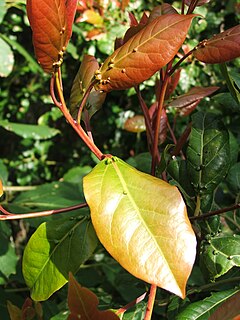
Ocotea is a genus of flowering plants belonging to the family Lauraceae. Many are evergreen trees with lauroid leaves.

Ocotea bullata, is a species of flowering tree native to South Africa. It produces very fine and valuable timber which was formerly much sought after to make furniture. Due to over-exploitation it is now a protected species. Other names for it are Cape Walnut, Cape laurel, and laurel wood. The name "stinkwood" comes from a strong smell that is released when it is fresh felled.

Adhemarius dariensis is a species of moth in the family Sphingidae. It is known from Costa Rica, Mexico, Nicaragua and Panama.
Ocotea argylei is a species of Ocotea in the plant family Lauraceae. It is a medium-sized to large tree 10–21 m tall, in some case to 30 m. Its status is classed as vulnerable. It is endemic to Kenya. The fruits are oblong berries which are covered by a cup-shaped cupule where they join the peduncle, giving them an appearance similar to an acorn. The leaves are elliptic with an acuminate tip. O. argylei is classified in the Flora of Tropical East Africa by the Royal Botanic Gardens, of Kew as Ocotea kenyensis (Chiov.) Robyns & R. Wilczek, with which it is possibly synonymous.
Ocotea cymbarum is a species of Ocotea in the plant family Lauraceae. It is an evergreen tree found in Brazil, Colombia, French Guiana, Guyana, Suriname, and Venezuela.

Ocotea foetens, commonly called til or stinkwood is a species of tree in the family Lauraceae. It is evergreen and grows up to 40 m tall. It is a common constituent of the laurisilva forests of Madeira and the Canary Islands. Leaf fossils of this species are known from the Mio-Pleistocene of Madeira Island.
Ocotea harrisii is a species of plant in the genus Ocotea of the family Lauraceae. It is an evergreen tree endemic to Jamaica. It is threatened by habitat loss.
Ocotea kenyensis is a species of plant in the family Lauraceae. It is found in the Democratic Republic of the Congo, Ethiopia, Kenya, Malawi, Mozambique, Rwanda, South Africa, Sudan, Swaziland, Tanzania, Uganda, and Zimbabwe. It is threatened by habitat loss.
Ocotea lancilimba is a species of plant in the family Lauraceae. It is an evergreen tree in the genus Ocotea. It is endemic to Mauritius. Its natural habitat is subtropical or tropical dry forests.

Ocotea porosa is a species of plant in the Lauraceae, often placed in the related genus Phoebe. It is commonly called imbuia or Brazilian walnut because its wood resembles that of some walnuts. The tree is a major commercial timber species in Brazil, used for high-end furniture, mostly as decorative veneers, and as flooring. The wood is very hard, measuring 3,684 lbf on the Janka scale. The wood is also fragrant with hints of nutmeg and cinnamon. The tree is also a popular horticultural tree in subtropical regions of the world. In its native habitat it is a threatened species.

Ocotea odorifera is a species of plant in the family Lauraceae. It is an evergreen tree in the genus Ocotea.
Ocotea puberula is a species of evergreen tree in the plant genus Ocotea of the family Lauraceae. It is found in Argentina, Brazil, French Guiana, Guyana, Mexico, Peru, and Suriname.
Ocotea rivularis is a species of evergreen tree in the plant genus Ocotea of the family Lauraceae. It is endemic to Costa Rica.
Ocotea rugosa is a species of evergreen tree to 10 m (33 ft) tall in the plant genus Ocotea, in the family Lauraceae. It is endemic to Andean Ecuador at an altitude of 1,700 to 2,500 m. Its natural habitat is subtropical or tropical moist montane forests and cloud forest. This species requires moisture and protection of other trees for growing. The principal threats are fires, grazing, and the conversion of forest to farmland.
Ocotea uxpanapana is a species of plant in the family Lauraceae. It is a species of evergreen tree in the genus Ocotea.

Adhemarius palmeri is a moth of the family Sphingidae first described by Jean Baptiste Boisduval in 1875.

Adhemarius tigrina is a moth of the family Sphingidae.

Adhemarius eurysthenes is a species of moth in the family Sphingidae. It was described by Rudolf Felder in 1874, and is known from Brazil, Colombia and Paraguay.

Adhemarius roessleri is a species of moth in the family Sphingidae. It was described by Ulf Eitschberger in 2002, and is known from Brazil, Colombia, Guyana, northern Peru and French Guiana.

Adhemarius ypsilon is a species of moth in the family Sphingidae. It was described by Rothschild and Jordan in 1903 and is known from Costa Rica, Mexico, Belize, Guatemala, Nicaragua, Venezuela, French Guiana, Ecuador, Peru, and Bolivia.










